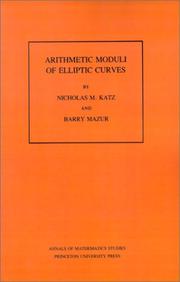| Listing 1 - 2 of 2 |
Sort by
|

ISBN: 0691083525 0691083495 1400881714 Year: 1985 Publisher: Princeton, N.J.
Abstract | Keywords | Export | Availability | Bookmark
 Loading...
Loading...Choose an application
- Reference Manager
- EndNote
- RefWorks (Direct export to RefWorks)
This work is a comprehensive treatment of recent developments in the study of elliptic curves and their moduli spaces. The arithmetic study of the moduli spaces began with Jacobi's "Fundamenta Nova" in 1829, and the modern theory was erected by Eichler-Shimura, Igusa, and Deligne-Rapoport. In the past decade mathematicians have made further substantial progress in the field. This book gives a complete account of that progress, including not only the work of the authors, but also that of Deligne and Drinfeld.
Curves, Elliptic --- Moduli theory --- Theory of moduli --- Functions of several complex variables --- Elliptic curves --- Curves, Algebraic --- Geometry, Algebraic --- 511.3 --- Analytic spaces --- Algebraic geometry --- Geometry --- 511.3 Analytical, additive and other number-theory problems. Diophantine approximations --- Analytical, additive and other number-theory problems. Diophantine approximations --- Ordered algebraic structures --- Curves, Elliptic. --- Moduli theory. --- Geometry, Algebraic. --- Abelian variety. --- Addition. --- Algebraic variety. --- Algebraically closed field. --- Ambient space. --- Arithmetic. --- Axiom. --- Barry Mazur. --- Base change. --- Calculation. --- Canonical map. --- Change of base. --- Closed immersion. --- Coefficient. --- Coherent sheaf. --- Cokernel. --- Commutative property. --- Congruence relation. --- Coprime integers. --- Corollary. --- Cusp form. --- Cyclic group. --- Dense set. --- Diagram (category theory). --- Dimension. --- Discrete valuation ring. --- Disjoint union. --- Divisor. --- Eigenfunction. --- Elliptic curve. --- Empty set. --- Factorization. --- Field of fractions. --- Finite field. --- Finite group. --- Finite morphism. --- Free module. --- Functor. --- Group (mathematics). --- Integer. --- Irreducible component. --- Level structure. --- Local ring. --- Maximal ideal. --- Modular curve. --- Modular equation. --- Modular form. --- Moduli space. --- Morphism of schemes. --- Morphism. --- Neighbourhood (mathematics). --- Noetherian. --- One-parameter group. --- Open problem. --- Prime factor. --- Prime number. --- Prime power. --- Q.E.D. --- Regularity theorem. --- Representation theory. --- Residue field. --- Riemann hypothesis. --- Smoothness. --- Special case. --- Subgroup. --- Subring. --- Subset. --- Theorem. --- Topology. --- Two-dimensional space. --- Zariski topology.
Book
ISBN: 1400826950 Year: 2005 Publisher: Princeton, NJ : Princeton University Press,
Abstract | Keywords | Export | Availability | Bookmark
 Loading...
Loading...Choose an application
- Reference Manager
- EndNote
- RefWorks (Direct export to RefWorks)
It is now some thirty years since Deligne first proved his general equidistribution theorem, thus establishing the fundamental result governing the statistical properties of suitably "pure" algebro-geometric families of character sums over finite fields (and of their associated L-functions). Roughly speaking, Deligne showed that any such family obeys a "generalized Sato-Tate law," and that figuring out which generalized Sato-Tate law applies to a given family amounts essentially to computing a certain complex semisimple (not necessarily connected) algebraic group, the "geometric monodromy group" attached to that family. Up to now, nearly all techniques for determining geometric monodromy groups have relied, at least in part, on local information. In Moments, Monodromy, and Perversity, Nicholas Katz develops new techniques, which are resolutely global in nature. They are based on two vital ingredients, neither of which existed at the time of Deligne's original work on the subject. The first is the theory of perverse sheaves, pioneered by Goresky and MacPherson in the topological setting and then brilliantly transposed to algebraic geometry by Beilinson, Bernstein, Deligne, and Gabber. The second is Larsen's Alternative, which very nearly characterizes classical groups by their fourth moments. These new techniques, which are of great interest in their own right, are first developed and then used to calculate the geometric monodromy groups attached to some quite specific universal families of (L-functions attached to) character sums over finite fields.
Monodromy groups. --- Sheaf theory. --- L-functions. --- Addition. --- Additive group. --- Affine space. --- Algebraic group. --- Algebraic integer. --- Algebraically closed field. --- Automorphism. --- Base change. --- Big O notation. --- Central moment. --- Change of base. --- Character sum. --- Classical group. --- Codimension. --- Computation. --- Conjecture. --- Conjugacy class. --- Constant function. --- Convolution. --- Corollary. --- Critical value. --- Dense set. --- Determinant. --- Dimension (vector space). --- Dimension. --- Diophantine equation. --- Direct sum. --- Discrete group. --- Disjoint sets. --- Divisor (algebraic geometry). --- Divisor. --- Eigenvalues and eigenvectors. --- Elliptic curve. --- Empty set. --- Equidistribution theorem. --- Existential quantification. --- Exponential sum. --- Faithful representation. --- Finite field. --- Finite group. --- Fourier transform. --- Function field. --- Function space. --- Generic point. --- Group theory. --- Hypersurface. --- Inequality (mathematics). --- Integer. --- Irreducible representation. --- Isomorphism class. --- L-function. --- Leray spectral sequence. --- Linear space (geometry). --- Linear subspace. --- Moment (mathematics). --- Monodromy. --- Morphism. --- Natural number. --- Normal subgroup. --- Orthogonal group. --- P-value. --- Parameter space. --- Parameter. --- Parity (mathematics). --- Partition of a set. --- Perverse sheaf. --- Polynomial. --- Power series. --- Prime number. --- Probability space. --- Probability theory. --- Proper morphism. --- Pullback (category theory). --- Random variable. --- Reductive group. --- Relative dimension. --- Root of unity. --- Scalar multiplication. --- Scientific notation. --- Set (mathematics). --- Sheaf (mathematics). --- Special case. --- Subgroup. --- Subobject. --- Subset. --- Summation. --- Surjective function. --- Symmetric group. --- Symplectic group. --- Tensor product. --- Theorem. --- Theory. --- Topology. --- Trace (linear algebra). --- Trivial group. --- Unipotent. --- Variable (mathematics). --- Variance. --- Vector space. --- Zariski topology.
| Listing 1 - 2 of 2 |
Sort by
|

 Search
Search Feedback
Feedback About UniCat
About UniCat  Help
Help News
News